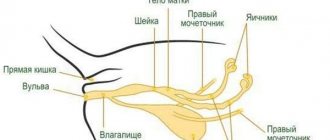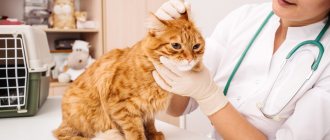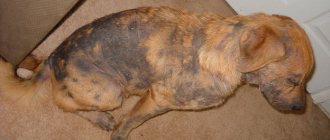By the behavior of a pet you can judge its well-being. And if your dog’s ears are constantly itching, while he shakes his head, whines a little and tilts his head to one side, this indicates problems with the hearing organs. Such symptoms cannot be ignored, as serious complications can occur if not treated promptly.
Itching in the ear indicates the development of an inflammatory process
Why does a dog scratch its ears - the causes of the disease
Sometimes the reason for this behavior of an animal may be a specific form of an organ, which provokes an inflammatory process. This is most often observed in terriers, Yorkies, Spitz dogs, poodles, and mastiffs. In these breeds, the auricle is designed in such a way that secretions accumulate in it and there is insufficient ventilation. Therefore, untimely removal of discharge can cause redness and inflammation. In this case, it is enough to clean it and try to avoid heavy contamination in the future.
But not always when a dog scratches its ear, this indicates the need for hygiene procedures. Often this symptom is associated with the development of a concomitant disease that requires treatment.
The main causes of the disease:
- parasite infection;
- hypersensitive reaction of the pet’s body;
- infections;
- improper ear cleaning;
- presence of a foreign object;
- injuries, tumors.
Important! In some pets, itching may occur due to long hair, which, when it gets into the ear, causes irritation.
Hematoma of the auricle
The condition is characterized by the accumulation of blood in the cavity under the skin of the auricle. The cause is mechanical damage - bite, blow, squeezing, etc. After two or three days, a blood clot forms, and fibrin clots settle at the bottom of the hematoma. If pathogenic microorganisms get inside, an inflammatory process may develop.
Hematoma is determined by the following symptoms:
- the auricle is increased in size;
- on its outer or inner side a fluctuating, sharply limited swelling is noticeable;
- the dog is restless, shaking its head;
- sometimes (if infected) a hematoma suppurates.
Treatment of otohematoma can be carried out using two methods: conservative or surgical. Conservative involves diverting the contents of the hematoma followed by administration of a solution containing an antibiotic, novocaine and dexamethasone. This is done to reduce swelling and suppress microflora. Then apply a tight bandage. The disadvantage of this treatment is that after a few days a relapse occurs, and if after several procedures the situation does not change, they resort to the surgical method.
Surgical treatment of otohematomas consists of washing the cavity with antiseptic solutions and suturing the ear through to stop bleeding and create adhesive inflammation. This method is the most effective.
Ear diseases that cause itching - symptoms
In most cases, if a dog scratches its ear and periodically whines, this indicates the development of an inflammatory process caused by diseases. Each of them is characterized by certain symptoms that you need to pay attention to.
Otitis
The disease develops as a result of microorganisms entering the animal’s auditory organ. Experts distinguish 3 types of otitis: external, middle and internal. Pets are more susceptible to it, often suffering from allergies, in which hair is present in the ear canals, and the body is covered with folds.
With otitis externa, inflammation occurs in the visible part of the ear. Infected lesions are also possible. In the middle type of the disease, a part of the auditory organ that is invisible to the naked eye is affected. In this case, the dog actively scratches its ears until it hurts. There is also abundant clear discharge, and a gurgling sound is heard when massaging the ear.
Otitis media is the most common disease in dogs.
With internal otitis, the pet feels severe, sharp pain. It becomes difficult for him to turn his head, so he turns his whole body. At the same time, the animal’s general health deteriorates, it loses its appetite, its nose becomes hot and dry.
Allergy
Ear irritation in a puppy or dog can be caused by a reaction of the endocrine system to an allergen. It can be triggered by new food, medicine, or pollen. With allergies, not only do your pet's ears become red and thick, but their eyes also become watery and there may be copious nasal discharge.
Foreign body
Another reason why a dog's ears constantly itch may be a foreign body that has entered the ear canal and caused irritation. Most often this comes from a plant seed, a small lump of earth, or an insect. When a foreign body enters, symptoms occur suddenly. The dog begins to shake its head, shows concern, and tries to get its paw into its ear.
Otodectosis
The ear organ can itch as a result of the development of the disease otodectosis, caused by the ear mite Otodectes. The parasite has a microscopic size, which makes diagnosis difficult at the initial stage of the lesion. The mite reproduces in the ear canal, since there are all the necessary conditions for this - moisture and warmth. It feeds on dog blood, lymph, skin particles, and sulfur.
Important! Otodectosis is a contagious disease, and is quickly transmitted from a sick dog to a healthy one upon contact.
When a nursing dog is infected with an ear mite, the parasitic infection spreads to the puppies, which can cause their death.
The main symptoms of otodectosis:
- head shaking;
- severe itching in your pet's ears;
- scratching on the face and back of the head;
- brown plaque in the ears.
As a result of the activity of mites, crusts form in the dog’s ear canal, which over time begin to smell unpleasant and emit a putrid odor. The dog may also scratch areas near the ears in an attempt to reduce discomfort. As a result, bald spots appear in these places.
Lack of adequate treatment can lead to blockage of the canals, rupture of the eardrum, and a sharp increase in body temperature to a critical level. Subsequently, the inflammatory process spreads to the middle ear and can switch to the meninges, which is extremely dangerous.
Otodectosis affects both ears
General information
REFERENCE! There is a caste of owners who do not want to wash their dog. For man's faithful friend, washing is mandatory once every three days! Otherwise, there is a risk of finding lice (animals) or fleas. The animal may shake its head because it lacks cleanliness.
There are only three painful reasons why your pet’s ear will itch and his head will shake:
- Pain from illness. A common symptom of internal otitis is acute pain. A dog will never be able to tell you that his ear hurts, and you are unlikely to ask. If you ask yourself: “why does a dog often scratch its ears,” then otitis media could be the cause;
- Tumor. The thing is more terrible than simple otitis media. Tumors are rarely internal, and otherwise you will have to take your pet to the veterinary clinic. To find it, do a simple inspection. The tumor is either in the ear itself or outside. The dog will let you know about this;
- An unpleasant smelling liquid leaks from the ears. Pathological symptoms often lead to what is called “pus”. Bruise, otitis media, dirt damage - all this entails the release of an unpleasant odor. And again the same advice: examine the dog.
REFERENCE! Check your dog at least once a week. A full examination will not take you 30 minutes (a whole article about this will appear soon), and you will significantly save on the veterinarian in the future, and on the ailments of your faithful friend in the present. Please spend time with your dog in more than just playtime.
How to relieve itching at home
If your dog starts shaking his head and scratching his ears, you can try to help him at home to relieve inflammation and reduce discomfort. To do this you will need hydrogen peroxide and ear sticks. Removing crusts, pus, and secretions will improve air access to the inflamed areas of the hearing organ. As a result, the wounds will begin to dry out, and the local temperature will normalize. This will relieve the primary itching and reduce the pet’s pain.
You should also treat scratches on the skin with wound-healing hydrocortisone ointment. Novocaine blockade around the auditory organ also helps relieve itching.
If there are no special processing agents at hand, you can use purified birch tar. You need to apply it a little, in an even layer. This will relieve inflammation, eliminate itching, and destroy bacteria and parasites. The main thing is to determine whether the dog is allergic to this drug.
Important! Do not deep clean the ear to avoid damaging the eardrum.
If otitis media develops and is infested with ticks, the dog should be shown to a veterinarian. He will prescribe special medications that need to be dripped into the ears at night. You should not try to treat the disease on your own, as this can lead to serious consequences for the pet’s health.
If a foreign body gets into your ear, you can try to remove it with tweezers. You cannot use a match or straw for this, as this may promote deeper penetration into the ear canal. If you cannot get the item yourself, you should contact a specialist.
Only a doctor can correctly prescribe treatment
Allergic otitis media
Ears are one of the most delicate and vulnerable places. If a dog has inflammation and otitis media of the external auditory canal, then in approximately 70% of cases it will be associated with allergies. The ears become inflamed with food allergies and with atopic dermatitis (allergies to environmental allergens) and allergies to parasites. The outer ear will appear inflamed, and when the owner tries to look inside, the dog may whine, snarl, and try to hide or run away. When examined by a veterinarian through an otoscope, inflammation with discharge (inflammatory secretion) will be detected.
As a rule, treatment for allergic otitis is complex and will be prescribed by a doctor individually for each dog. The treatment regimen may greatly depend on the cause of the allergy. In addition to complex treatment aimed at eliminating the cause of the allergy and relieving symptoms, sanitation and treatment of the ear canal with antibacterial and antifungal drugs will also most likely be prescribed. In order to reduce itching during treatment and thereby make the dog’s life easier, the doctor may prescribe Apoquel. This drug will relieve attacks of itching and eliminate the factor of trauma when scratching; it also helps relieve inflammation.
Preventing itchy ears in your pet
To reduce the likelihood of itching in your pet, you must not neglect hygiene procedures. It is also recommended to inspect the ears every morning to identify the problem in a timely manner.
Prevention of itching is based on regular ear cleaning with a special lotion. To do this, you need to pour a small amount of the product into the ear canal, then massage it lightly and allow the dog to shake its head well. As a result, the wax will end up on the inside of the ear, where it can be easily removed with a napkin.
Prevention helps avoid serious problems
Diagnostics
Only a veterinarian can make a diagnosis based on anamnesis (collection of information about the pet’s lifestyle), examination and additional research. For example, otoscopy of the middle and inner ear will make it clear where the inflammatory process is localized, and microscopy of the discharge from the auricle will show what exactly could cause the inflammation.
What symptoms may bother your dog besides itching:
- pain - the dog will whine and actively rub its ear with its paws, tilting its head. Trying to look may cause anxiety, discomfort or aggression on the part of the animal;
- a “squelching” sound when pressing on the base of the ear or when the dog shakes its head;
- local redness of the skin, swelling;
- discharge from the ear that is black, gray, yellow or off-white;
- foul odor from the ears;
- enlarged submandibular lymph nodes, general depressed condition of the dog, lethargy;
Each of these symptoms indicates that something is wrong with your ears. The solution to the problem must be approached comprehensively and as quickly as possible.
Itchy ear - what could it be?
How to identify the cause of anxiety
The first thing to do is to examine the ear for the presence of a foreign body. It is important to clean the ear of discharge and possible pus. With otitis media of a bacterial nature, the ear squishes. Parasitic otitis media is characterized by black discharge. It is important to take a sample for analysis. The scraping can reveal parasites (mites) under a microscope. A smear is also taken for bacterial culture, which is sent to the laboratory. There, a colony of the pathogen is grown on a special medium, differentiated, and tested for sensitivity to antibiotics. Lice, lice and various other parasites are detected visually.
Treatment
In the early stages of ear scabies, you can do the procedures yourself, with the help of family members. Place the dog on its side, calm it down, and fix its head. Using cotton swabs soaked (optional) in hydrogen peroxide, in solutions of furatsilin (1:10,000), boric acid (3%), rivanol (0.1%), moisten the affected surfaces of the ear. Wait a few minutes for the crust to soften and remove it. If treatment is carried out with the drug Otoferonol, then you can moisten the tampon with the same product.
It is necessary to clean the auricle of purulent and serous discharge, remove the crust, and thoroughly clean the ear. This is an indispensable condition, without which subsequent treatment will be ineffective. Uncleaned dirt in the ear will not give the medicine access to the mites that are located under the epidermis of the skin. A new tampon is used each time for one action. This will prevent infection from spreading to healthy areas of the ears. Then you need to drop the required amount of medicine into your ear. It is advisable to keep the dog for a while in a motionless state, in which the treatment was carried out. After instillation, the dog shakes its body, the medicine flies out and the effectiveness of the treatment decreases. If possible, massage gently behind the ears with the pads of your fingers.
It doesn’t matter whether the dog’s second ear hurts or not, both are subject to the procedure.
Treatment must be repeated after 10 days. Otherwise, the remaining tick eggs will develop into adults and the disease will resume. In advanced stages, treatment is carried out by specialists. In case of complications (otitis media and labyrinthitis), surgery cannot be ruled out.
Briefly about the main thing
- Due to their anatomy, the ears are susceptible to diseases. Common problems include otitis media, tick infestation, allergies, and foreign body ingestion.
- Ear diseases are accompanied by itching and tilting of the head to the side. There may be a decrease in appetite and problems with sleep.
- Treatment can only be prescribed by a doctor. To make you feel better, you need to massage your ears and clean the shells of secretions.
- Proper ear care is an important part of preventing diseases and infections. It is required to carry out systematic cleaning, hair removal and treatment for parasites. Visit your veterinarian twice a year for a checkup.
Have you ever experienced ear problems in your dog? Share in the comments how to relieve your pet’s anxiety and discomfort before visiting the clinic.










